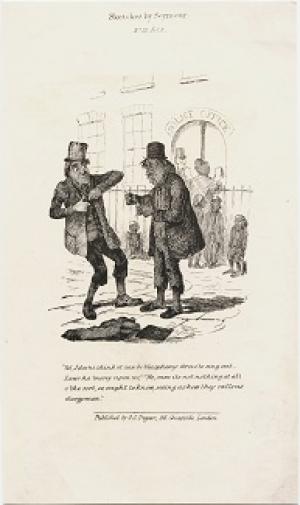Past Master Classes
Artful Nature: Fashion and Theatricality, 1770-1830 (2020)
The Comic Image 1800–1850: Narrative and Caricature (2016)
Hogarth to Cruikshank: the Comic Image 1750-1850 (2011 and 2012)
British History Painting in the Long Eighteenth Century (2011 and 2014)
Caricature and the Comic Image 1800-1850 (2008-2012 and 2014)
Artful Nature: Fashion and Theatricality, 1770-1830 Masterclass
February 7, 2020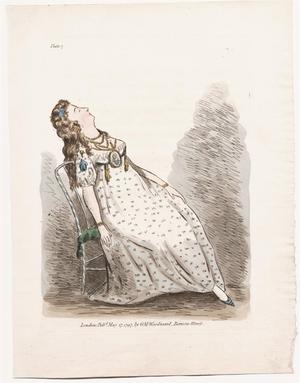
10:00 a.m. to 1:00 p.m.
The Lewis Walpole Library
Farmington, Connecticut
The Lewis Walpole Library is pleased to host an objects-based masterclass around the exhibition Artful Nature: Fashion and Theatricality, 1770-1830 which opens at the library on February 6, 2020. The exhibition is organized by guest curators Laura Engel, Professor of English, Duquesne University, and Amelia Rauser, Professor of Art History, Franklin & Marshall College, with Cynthia Roman, the library’s Curator of Prints, Drawings and Paintings.
Between 1770 and 1830, both fashionable dress and theatrical practice underwent dramatic changes in an attempt to become more “natural.” And yet this desire was widely recognized as paradoxical, since both fashion and the theater were longstanding tropes of artifice. This exhibition examines this paradox of “artful nature” through the changing conception of theatricality during these decades, as mirrored and expressed in fashionable dress. Theater and performance practices in the late eighteenth-century, including the vogue for private theatricals, reinforced the blurred lines between the theater and everyday life. Classical sculpture became a reference point for women, as its artistic excellence was acclaimed precisely because it seemed so “natural.” But when actresses, dancers, painters, or fashionable women posed themselves as classical statues come to life, they acted as both Pygmalion and Galatea, both the genius artist and the living artwork. “Artful Nature” refers simultaneously to the theatricality and deception typically attributed to fashionable women in the late eighteenth century, and at the same time to the potential survival strategies employed by women artists, authors, and actresses to craft their own parts.
The masterclass program will begin at 10:00 with a tour of the exhibition by Professor Rauser and Professor Engel. Following the tour, we will gather in the reading room at 11:00 for discussion around items selected from the library’s collection with Meredith Gamer, Assistant Professor of Art History, Columbia University, and Carolyn Day, Associate Professor of History, Furman University.
Participants may also want to attend a keynote lecture Fashionable Enemies: Glamour as Argument, 1770-1830 by Joseph Roach, Sterling Professor Emeritus of Theater and Professor Emeritus of English, Yale University, at the Yale Center for British Art at 5:30 on February 6, 2020.
A Contest of Two Genres: Graphic Satire and Anglo-American History Painting in the Long Eighteenth Century
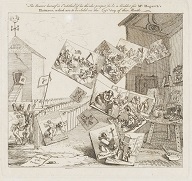
Mark Salber Phillips, Professor of History at Carleton University, Ottawa
Cynthia Roman, Curator of Prints, Drawings, and Paintings at the Lewis Walpole Library
May 15-18, 2017
Centuries-old hierarchies of the visual arts have placed history painting and graphic satire at opposite ends of the spectrum. “History painting” – high minded narrative art depicting exemplary heroes and events— carried enormous prestige, bringing fame to the individual artist as well as to the national school. In contrast, graphic satire was viewed as the lowest form of visual expression – more closely connected to political prints than to high-minded “histories.”
This residential seminar is intended to give doctoral students in a variety of disciplines the opportunity to consider issues and overlaps between these two narrative genres. Making use of visual material and textual resources from the collections of the Lewis Walpole Library’s at Yale, we will examine the often-embattled efforts of artists to construct new modes of visual representation as well as of narrative and history. Through a multidisciplinary approach, we will take note of a variety of key issues, including the theoretical context of Enlightenment intellectual history, the more focused discourse of art treatises, and direct encounters with the formal and aesthetic qualities of works of art. Among history painters we will give our attention to the works of William Hogarth, Gavin Hamilton, Benjamin West, and John Trumbull, while among the satirists we will focus on James Gillray, Thomas Rowlandson, and Isaac and George Cruikshank.
The class will be taught as a combination of seminars, small group discussions, and visits to the Yale Center for British Art, the Yale University Art Gallery, and the Wadsworth Atheneum Museum of Art. Most of the teaching will take place in the Lewis Walpole Library in Farmington.
The Comic Image 1800–1850: Narrative and Caricature
September 14, 1 pm, to September 16, 4 pm 2016
Brian Maidment, Professor of the History of Print, Liverpool John Moores University
Cynthia Roman, Curator of Prints, Drawings, and Paintings at the Lewis Walpole Library
Despite the rather specialized topic suggested by the title, this residential seminar aims to introduce participants both to the broad interpretative issues raised by studying prints and graphic images and to the range of collections available at the Lewis Walpole Library in Farmington.
While the library has an extremely rich collection of eighteenth-century caricature and political satire prints by such well-known artists as William Hogarth, James Gillray, and Thomas Rowlandson, it also has an extraordinarily wide range of comic images from the first half of the nineteenth century, images which evolve or re-invent traditions of caricature and satiric narrative to bear on social themes, especially the day to day experience of urban life. Less widely studied and reproduced than the caricatures of the late eighteenth century, this corpus of early nineteenth-century prints nonetheless forms an excellent starting place for studying the graphic tradition and tracing changes in narrative strategies. As political and personal satire gave way to a focus on wider socio-cultural themes in comic image-making, intaglio engraving was substantially replaced by lithography and wood engraving as the favored media, thus opening up new possibilities in combining printed texts and illustration. These rapid changes in mode and subject combined with a volatile and experimental marketplace to re-define the nature of humor in this period.
The residential seminar is intended to provide an opportunity for students across disciplines to work with the Lewis Walpole Library’s collections and to think over issues to do with the value, status, and methodological challenges offered by the study of graphic material. No previous experience of working with prints or other graphic images is required. The number of participants is limited, and preference is given to graduate students.
The class will be taught through a range of small group workshops and discussions centered on the library collections. It will be led by Brian Maidment and Cynthia Roman, and build on the experience of many previous successful classes in Farmington.
Hogarth to Cruikshank: the Comic Image 1750-1850
May 19, 2012
May 14, 2011
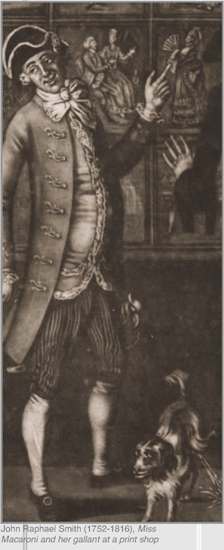
Led by Brian Maidment, then Research Professor in the History of Print at Salford University in Manchester, UK
and
Cynthia Roman, Curator of Prints, Drawings, and Paintings at the Lewis Walpole Library
For several years the Lewis Walpole Library has hosted Brian Maidment’s highly popular one-week master class for Yale graduate students (see below). The Library has also hosted one-day versions of the class for special audiences.
Senior Scholars: in 2012, for the first time, the library invited senior scholars from a variety of disciplines whose research encompasses graphic satire and caricature to a one-day workshop with Professsor Maidment, Research Professor in the History of Print at Salford University in Manchester, UK, and Cynthia Roman, Curator of Prints, Drawings, and Paintings at the LWL. The workshop addressed important past and current scholarship on comic imagery and visual humor between 1750 and 1850. The day was an opportunity for participants to share current research projects with colleagues and for the group to frame larger questions and new directions for scholarship.
Community: in 2011, for the first time, the library invited members of the community to a one-day version of the popular master class with Professor Maidment and Cynthia Roman.
This one-day class used the huge collections of caricatures and other comic prints held at the Lewis Walpole Library in Farmington as a means of exploring visual humor in the century between 1750 and 1850. During this period, the political caricature first flourished and then withered as the dominant form of visual comedy to be replaced by a broader marketplace for graphic images that reflected the interests of the rapidly changing urban population. The same period saw the overthrow of metal engraving and etching as the primary modes of making reproducible images in favor of wood engraving and lithography.
The class was designed to give a brief overview of these developments using prints drawn from the Lewis Walpole Library collections. Participants spent the day working with primary material from the period. Prints by both well known figures like Hogarth, Gillray and Rowlandson and by relatively obscure jobbing artists and engravers were considered. The teaching was relatively informal and exploratory rather than narrowly didactic. No previous experience of working with prints was required, and participants were encouraged to become engaged in discussion of these images and their possible interpretations.
The class was organized round three primary themes – The Forms of Visual Comedy; Print Making Techniques and their History; and Caricature and Society 1750-1850.
The session on ‘Forms of Visual Comedy’, using both prints and illustrations, tried to define the nature of visual humor in the eighteenth and nineteenth, especially caricature. The class considered terms like ‘caricature’ and ‘cartoon’, and thought about the different sorts of humor available to the artist - ‘satire’, ‘invective’, ‘parody’, ‘pastiche’, ‘the grotesque’ and ‘whimsy’ among them. The aim of the session was to introduce the variety of humorous ways of looking suggested by caricatures and other forms of graphic humor from the period. ‘Print Making Techniques and their History’ offered help with recognizing the main print making techniques and their mode of operation, including metal engraving, mezzotint, etching, wood engraving and lithography. There was also some consideration of the social history of each of these reprographic methods to suggest why they enjoyed popularity during particular historical periods. ‘Caricature and Society 1750-1850’ used a wide variety of images of print shops to suggest ways in which contemporaries viewed the usefulness, dangers or other forms of social impact made by caricature and other forms of comic prints. Why was eighteenth century political and social caricature so free from censorship? Could rudeness be socially useful or even progressively reformist? How widespread or democratic was caricature as a form of social communication? Was caricature almost exclusively the preserve of genteel male sociability, or did large numbers of observers have access to it? Why did political caricature give way to the comedy of urban manners as the primary subject for graphic comedy from the 1820s on? How far can satirical prints be thought of as an early instance of Victorian social self-analysis? Discussion of these kinds of issues shaped this concluding session of the programme.
Brian Maidment is Research Professor in the History of Print at Salford University in Manchester, UK, and has long standing interests in the study of popular graphic traditions as well as a detailed knowledge of the Farmington collections. He has taught classes of this kind at Farmington since 2002. Cynthia Roman is the Lewis Walpole Library’s Curator of Prints, Drawings, and Paintings and has extensive experience of working with prints of all levels of aesthetic ambition and achievement.
British History Painting in the Long Eighteenth Century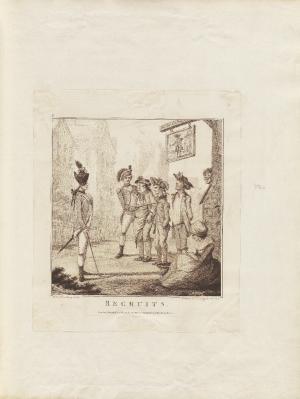
August 18-22, 2014 and August 22-26, 2011
Led by Mark Salber Phillips, Professor of History at Carleton University, Ottawa
and
Cynthia Roman, Curator of Prints, Drawings, and Paintings at the Lewis Walpole Library
The residential seminar was intended to give doctoral students in a number of disciplines the opportunity to consider issues of history painting using both visual material and textual resources from the Lewis Walpole Library’s collections. This course explored the often-embattled efforts of artists (including William Hogarth, Gavin Hamilton, Benjamin West and John Trumbull among others) to construct new modes of visual representations of narrative history and national history in particular. A multidisciplinary approach provided the theoretical context of Enlightenment intellectual history, the more focused discourse of art treatises, and direct encounters with the formal and aesthetic qualities of works of art.
The class was taught as a combination of lecture presentations, discussions, and small-group activities and included visits to the Yale Center for British Art, the Yale University Art Gallery, and the Wadsworth Atheneum Museum of Art. Most of the teaching took place in the Lewis Walpole Library in Farmington and was led by Mark Salber Phillips, Professor of History at Carleton University, Ottawa, and Cynthia Roman, Curator of Prints, Drawings, and Paintings at the Lewis Walpole Library.
The course was intended primarily for Yale students, but a limited number of places were available to graduate students from other universities.
Caricature and the Comic Image 1800-1850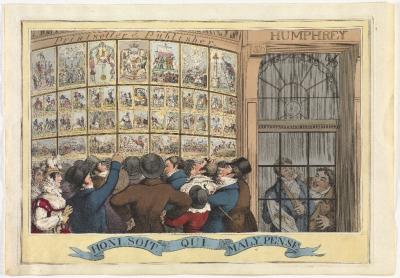
September 5-7, 2014
May 14-18, 2012
May 16-20, 2011
May 17-21, 2010
May 11-15, 2009
May 12 through 16, 2008
Led by Brian Maidment, Professor of the History of Print, Liverpool John Moores University
Despite the rather specialised topic suggested by the title, this residential seminar aimed to introduce doctoral students both to the broad interpretative issues raised by studying prints and graphic images and to the range of collections available at the Lewis Walpole Library in Farmington.
While the library has an extremely rich collection of eighteenth-century caricatures and other prints by such well known artists as Hogarth, Gillray, and Rowlandson, it also has a extraordinarily wide range of comic images from the first half of the nineteenth century, images which evolve or re-invent the caricature tradition to bear on social themes, especially the day to day experience of urban life. Less widely studied and reproduced than the caricatures of the late eighteenth century, this corpus of early nineteenth-century prints nonetheless forms an excellent starting place for studying the graphic tradition. As political and personal satire gave way to a focus on wider socio-cultural themes in comic image-making, intaglio engraving was substantially replaced by lithography and wood engraving as the favored media, thus opening up new possibilities in combining printed texts and illustration. These rapid changes in mode and subject combined with a volatile and experimental marketplace to re-define the nature of humor in this period.
The residential seminar was intended to give doctoral students in a number of disciplines the opportunity to work with the Lewis Walpole Library’s collections and to think over issues to do with the value, status, and methodological challenges offered by the study of graphic material. No previous experience of working with prints or other graphic images was required. The number of participants was limited.
The class has been taught through a number of different small group activities and has included visits to both the Yale Center for British Art and the Beinecke Rare Book and Manuscript Library in New Haven, and a print studio. Most of the teaching took place in the Lewis Walpole Library in Farmington and was led by Brian Maidment and Cynthia Roman.
